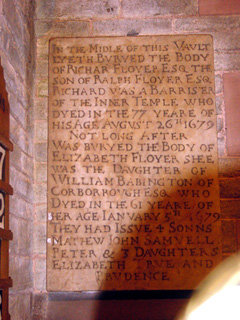|
The oldest pair of stones commemorate the Floyer family. This inscription reads; "Near this window ly interred the bodies of Ralph Floyer Esq Lord of this mannor of Hints & of Margery his wife one of the daughters of James Weston of Lichfield Esq which Ralph and Margery had issue one sonne and two daughters (vizt) Richard Mary & Elizabeth the said Margery changed this life for a better the 14th Nov 1609 and the said Raphe the 16th of February 1643" |
The Floyer family
|
|
|
On the opposite wall is a stone commemorating Richard Floyer, Ralph's only son. The inscription reads; "In the middle of this vault lyeth buryed the body of Richard Floyer Esq the son of Ralph Floyer esq. Richard was a barrister of the Inner Temple who died in the 77 year of his age August 26th 1679.Not long after he was buryed the body of Elizabeth Floyer shee was the daughter of William Babbington of Corborrough Esq who died in the 61 yeare of her age January 5th 1679 They had issue 4 sonns Mathew John Samuell Peter & 3 daughters Elizabeth True and Prudence |
|
IT has been disputed by different writers whether the origin of the family of Floyer was Norman or Saxon. A Norman origin has generally been taken for granted, because the name is first on record about the time of the Norman invasion of England; but such evidence as is afforded by the derivation of the name and the amount of land held is in favour of the contrary idea. A "Flo" is an arrow, was in use in Chaucer's time, and is of Saxon derivation. The suffix "er" denotes generally an agent or worker. The introduction of the "y" finds a parallel in "sawyer" and "lawyer." Hence Floyer is an arrow-maker, and is distinct from the Norman name for the same occupation, "Flechier," which afterwards passed into "Fletcher." The earliest spelling of the name, as it is found in the Domesday Survey, A.D. 1086, is "Floher," or in the Latin form, "Floherus." By the time of Henry III the middle "h" begins to be omitted, and it is written "Floer" or "le Floer." Towards the beginning of the 14th century the spelling "Floyer" or "le Floyer" becomes constant, except for a period during the 16th and 17th centuries, when in some places it shared the fate of many other names in having the middle "y" made into an "i", but there is no trace of members of the family ever having signed them-selves "Floier. " John Kestell Floyer, "Annals of the Family of Floyer, Transactions of the Devonshire Association for the Advancement of Science, Literature and Art, Aug. 1898 Submitter: Tim Sandberg |
|
| Addendum: contributed by Edward Ebden of Monmouthshire 22/07/09 I am a descendant from the Flyer's (later Floyer!) of Uttoxeter who purchased the manor of Hints in c 1601... |
|
|
Addendum: contributed by John Wassell 31/12/09 |
|

